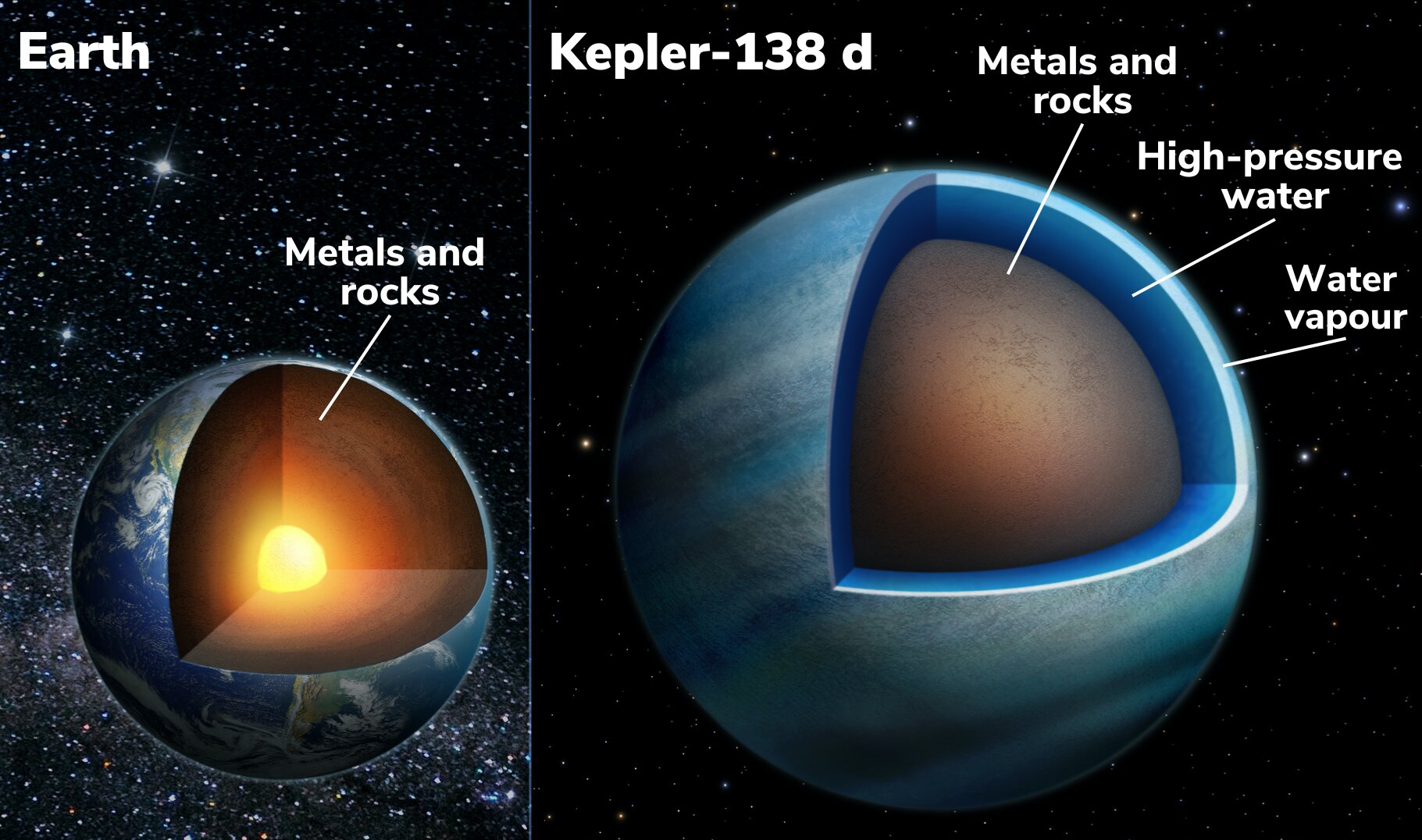A workforce led by UdeM astronomers has discovered proof that two exoplanets orbiting a purple dwarf star are “water worlds,” planets the place water makes up a big fraction of the quantity. These worlds, situated in a planetary system 218 light-years away within the constellation Lyra, are in contrast to any planets present in our solar system.
The workforce, led by Ph.D. pupil Caroline Piaulet of the Trottier Institute for Analysis on Exoplanets (iREx) on the Université de Montréal, revealed an in depth examine of a planetary system often known as Kepler-138 within the journal Nature Astronomy in the present day, December 15.
Piaulet, who’s a part of Björn Benneke’s analysis workforce, noticed exoplanets Kepler-138c and Kepler-138d with NASA’s Hubble and the retired Spitzer space telescopes and found that the planets—that are about one and a half instances the dimensions of the Earth—could possibly be composed largely of water. These planets and a planetary companion nearer to the star, Kepler-138b, had been found beforehand by NASA’s Kepler Area Telescope.
Water wasn’t immediately detected, however by evaluating the sizes and lots more and plenty of the planets to fashions, they conclude {that a} important fraction of their quantity—as much as half of it—must be made from supplies which might be lighter than rock however heavier than hydrogen or helium (which represent the majority of gas giant planets like Jupiter). The commonest of those candidate supplies is water.
“We beforehand thought that planets that had been a bit bigger than Earth had been large balls of steel and rock, like scaled-up variations of Earth, and that is why we known as them super-Earths,” defined Benneke. “Nevertheless, we have now now proven that these two planets, Kepler-138c and d, are fairly completely different in nature: a giant fraction of their total quantity is probably going composed of water. It’s the first time we observe planets that may be confidently recognized as water worlds, a kind of planet that was theorized by astronomers to exist for a very long time.”
With volumes greater than 3 times that of Earth and lots more and plenty twice as large, planets c and d have a lot decrease densities than Earth. That is shocking as a result of many of the planets simply barely larger than Earth which have been studied intimately thus far all gave the impression to be rocky worlds like ours. The closest comparability to the 2 planets, say researchers, could be among the icy moons within the outer solar system which might be additionally largely composed of water surrounding a rocky core.
“Think about bigger variations of Europa or Enceladus, the water-rich moons orbiting Jupiter and Saturn, however introduced a lot nearer to their star,” defined Piaulet. “As an alternative of an icy floor, Kepler-138 c and d would harbor massive water-vapor envelopes.”
Researchers warning the planets could not have oceans like these on Earth immediately on the planet’s floor. “The temperature in Kepler-138c’s and Kepler-138d’s atmospheres is probably going above the boiling level of water, and we anticipate a thick, dense environment made from steam on these planets. Solely beneath that steam environment there might doubtlessly be liquid water at excessive strain, and even water in one other phase that happens at excessive pressures, known as a supercritical fluid,” Piaulet stated.
Not too long ago, one other workforce on the College of Montreal discovered one other planet, known as TOI-1452 b, that would doubtlessly be lined with a liquid-water ocean, however NASA’s James Webb Area Telescope will probably be wanted to review its environment and make sure the presence of the ocean.
A brand new exoplanet within the system
In 2014, knowledge from NASA’s Kepler Area Telescope allowed astronomers to announce the detection of three planets orbiting Kepler-138, a red dwarf star within the constellation Lyra. This was primarily based on a measurable dip in starlight because the planet momentarily handed in from of their star, a transit.
Benneke and his colleague Diana Dragomir, from the College of New Mexico, got here up with the concept of re-observing the planetary system with the Hubble and Spitzer space telescopes between 2014 and 2016 to catch extra transits of Kepler-138d, the third planet within the system, with a purpose to examine its environment.
Whereas earlier NASA Kepler space telescope observations solely confirmed transits of three small planets round Kepler-138, Piaulet and her workforce had been stunned to seek out that the Hubble and Spitzer observations recommended the presence of a fourth planet within the system, Kepler-138e.
This newly discovered planet is small and farther from its star than the three others, taking 38 days to finish an orbit. The planet is within the liveable zone of its star, a temperate area the place a planet receives simply the correct quantity of warmth from its cool star to be neither too scorching nor too chilly to permit the presence of liquid water.
The character of this extra, newly discovered planet, nonetheless, stays an open query as a result of it doesn’t appear to transit its host star. Observing the exoplanet’s transit would have allowed astronomers to find out its measurement.
With Kepler-138e now within the image, the lots of the beforehand identified planets had been measured once more by way of the transit timing-variation technique, which consists of monitoring small variations within the exact moments of the planets’ transits in entrance of their star brought on by the gravitational pull of different close by planets.
The researchers had one other shock: they discovered that the 2 water worlds Kepler-138c and d are “twin” planets, with just about the identical measurement and mass, whereas they had been beforehand considered drastically completely different. The closer-in planet, Kepler-138b, then again, is confirmed to be a small Mars-mass planet, one of many smallest exoplanets identified to this point.
“As our devices and methods turn out to be delicate sufficient to seek out and examine planets which might be farther from their stars, we would begin discovering much more water worlds like Kepler-138 c and d,” Benneke concluded.
Extra info:
Caroline Piaulet, Proof for the volatile-rich composition of a 1.5-Earth-radius planet, Nature Astronomy (2022). DOI: 10.1038/s41550-022-01835-4. www.nature.com/articles/s41550-022-01835-4
Offered by
University of Montreal
Quotation:
Astronomers discover that two exoplanets could also be principally water (2022, December 15)
retrieved 15 December 2022
from https://phys.org/information/2022-12-montreal-astronomers-exoplanets.html
This doc is topic to copyright. Aside from any truthful dealing for the aim of personal examine or analysis, no
half could also be reproduced with out the written permission. The content material is offered for info functions solely.





